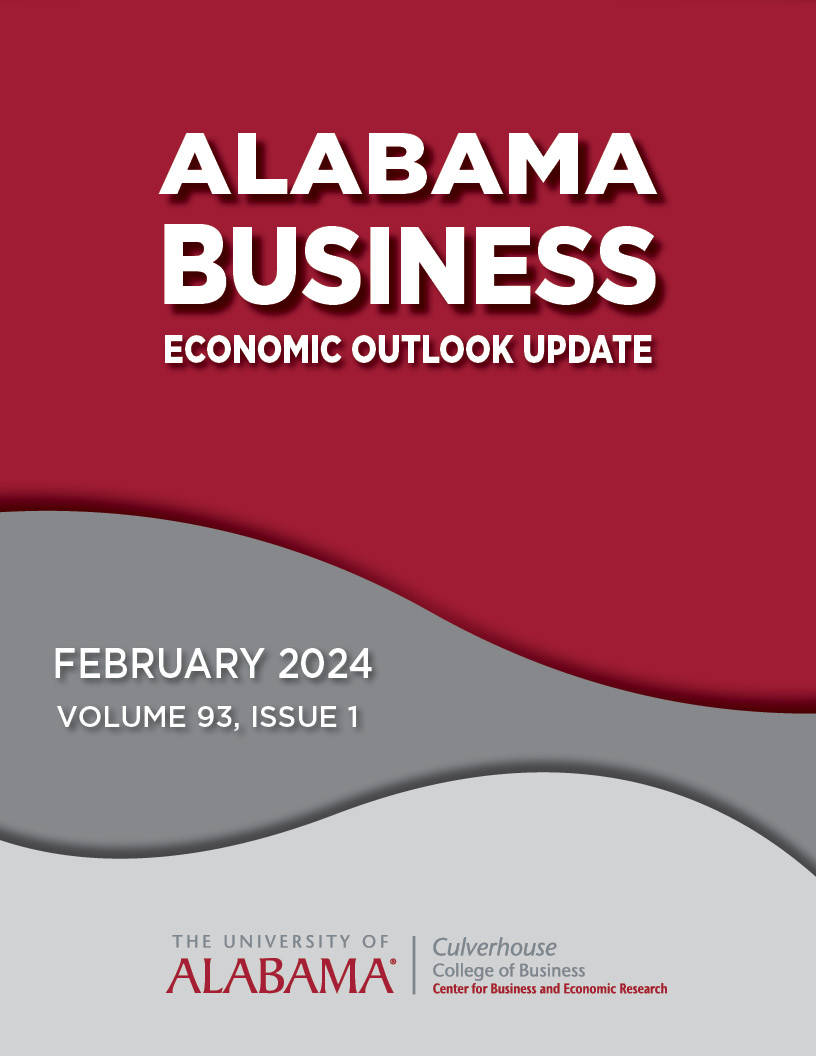Alabama Business™
Established in 1930, each issue contains a free quarterly Alabama economic forecast update.
Economic Outlook Update:
Alabama Business | February 2024
- Following a 2.2 percent growth in the first half of 2023, Alabama’s economy, as measured by its Gross Domestic Product (GDP), rose 4.9 percent in the third quarter and will most likely show an increase of about 3.0 percent in the fourth quarter. For all of 2023, Alabama’s economy is expected to show an increase of about 2.5 percent, with employment growing at 1.8 percent. For 2024, the state’s GDP will increase by about 1.5 percent while employment is forecasted to increase by 1.2 percent.
- The State gained only 300 jobs in December over the previous month, bringing the total net gain in jobs to 38,100 from December 2022 to December 2023, while the seasonally adjusted unemployment rate stayed flat at 2.6 percent
- During the same period, seasonally adjusted number of unemployed workers dropped from 59,986 to 65,462 and the labor force participation rate went up from 56.7 in December 2022 to 57.2 percent in December 2023.
- Year to date, total tax revenues increased by 2.4 percent in January 2024 to approximately $5.5 billion during the first four months of the current fiscal year. For the same period sales tax receipts declined 4.5 percent to about $1.0 billion while individual income tax revenues went up 1.7 percent, totaling approximately $1.9 billion. Total tax revenues are forecasted to increase by about 1.5 percent for the FY2023-2024.
- For 2023, Alabama export totaled $27.4 billion, up from $25.9 billion in 2022, a 5.8 percent increase. Transportation equipment remained state’s largest export, increasing from $11.6 billion in 2022 to $14.8 billion in 2023. Imports rose from approximately $37.08 billion in 2022 to $37.14 billion in 2023, an increase of only 0.2 percent. Germany remained the largest destination for Alabama exports, totaling $5.1billion in 2023, followed by Canada ($3.9 billion), China ($3.7 billion) and Mexico ($3.2 billion).
- U.S. economy grew by 3.3 percent during the fourth quarter 2023, down from 4.9 percent increase in the third quarter, during the first half of 2023, GDP rose by 2.2 percent. The increase in the fourth quarter was primarily due to increase in consumer spending (2.8 percent), exports (6.3 percent), state and local government spending (3.7 percent), business spending (1.9 percent), inventory investments, and residential fixed spending (1.1 percent). U.S. economy grew by 2.5 percent in 2023 and is expected to grow by about 1.2 percent and 1.1 percent in the first two quarters of 2024.
- U.S. inflation rate, as measured by consumer price index (CPI) rose by an annualized 4.1 percent in 2023, down from 8.0 percent in 2002, and the forecast for inflation rate calls for a 2.7 percent increase in 2024, with only a modest drop in interest rates.
- Despite the current interest rate environment and prospects of some slowdown in the U.S. economy, the employers continue to add to the payrolls, Total nonfarm payroll employment rose by 353,000 in January while the unemployment rate remained at 3.7 percent. Employment rose by an average of 255,000 per month in 2023. Job gains were seen in professional and business services (74,000), health care (70,000), retail trade (45,000), and social assistance (30,000). Payroll employment is expected to increase by 0.5 percent in the first quarter 2024 followed by 0.2 percent in the second quarter for an average annual increase of only 0.8 percent, down from 2.3 percent increase seen in 2023.
- Consumer spending will grow by 1.8 percent in 20243 and 1.2 percent in 2025. Overall business spending will increase by 2.4 percent in 2024 followed by 1.8 percent in 2025, while residential investments will rise only by 0.1 percent in 2024 and 1.7 percent in 2025. Residential investments, which include both home construction and sales increased for the first time during the second half of 2023, after nine straight quarterly declines.
Quarterly Report

